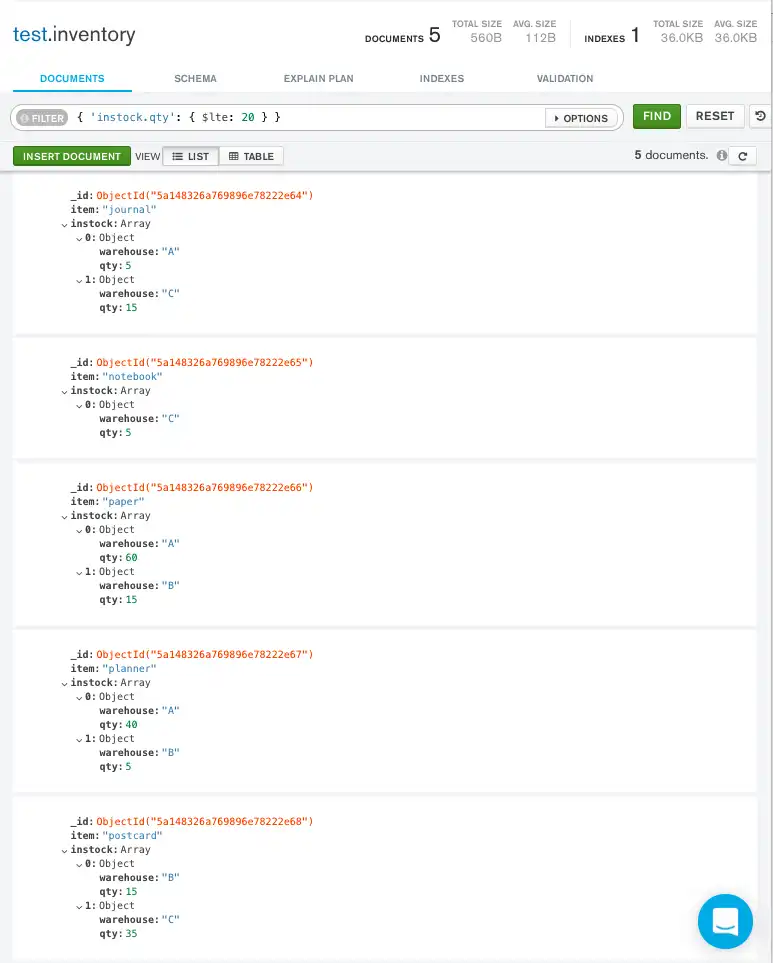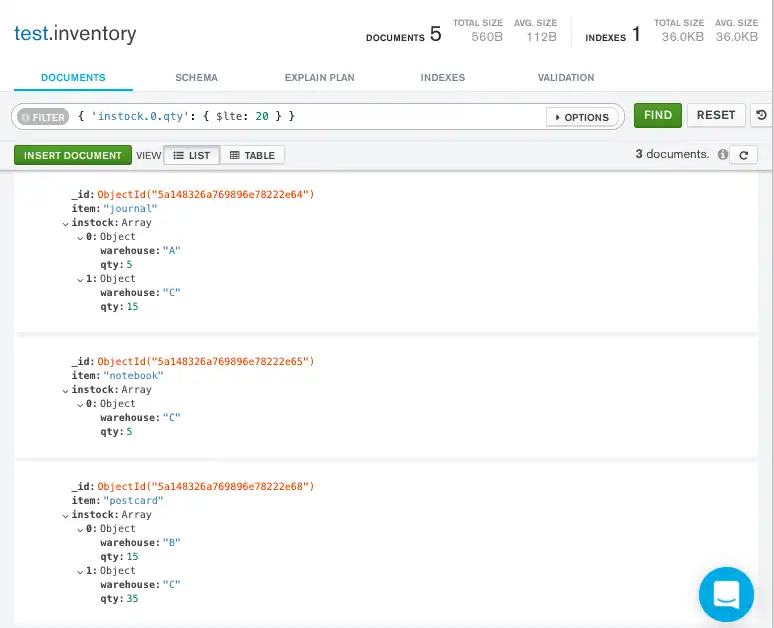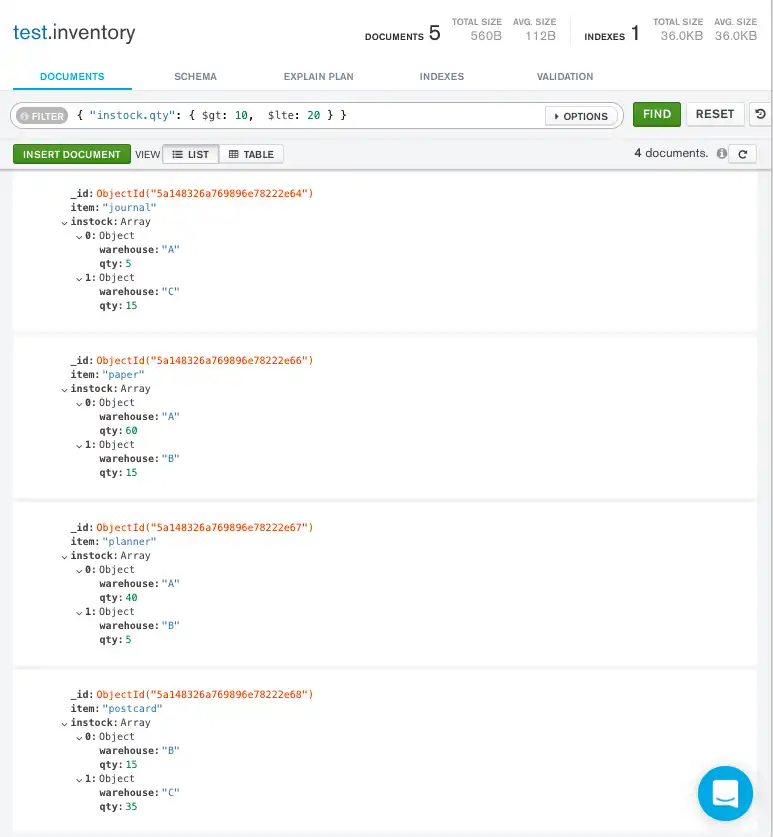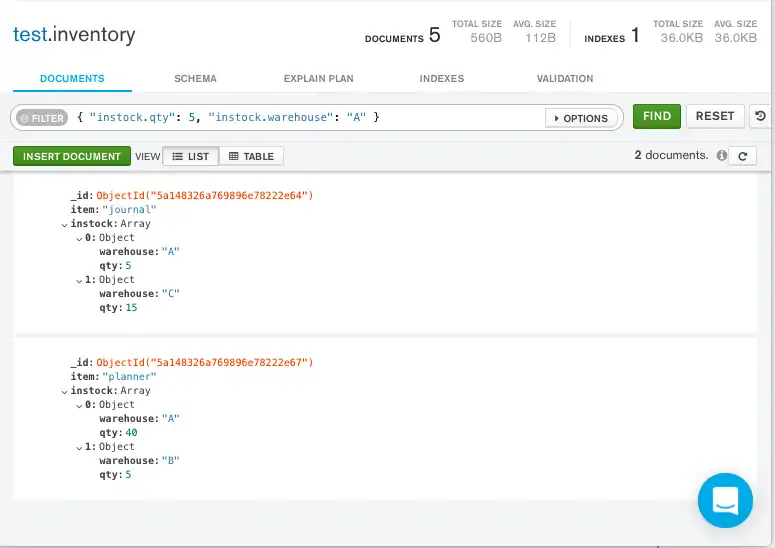내장된 문서 배열 쿼리하기
다음 메서드를 사용하여 MongoDB에서 문서를 쿼리할 수 있습니다:
프로그래밍 언어의 드라이버입니다.
MongoDB Atlas UI입니다. 자세한 정보는 MongoDB Atlas로 문서 배열 쿼리를에서 확인 가능합니다.
오른쪽 상단의 언어 선택 드롭다운 메뉴를 사용하여 다음 예시의 언어를 설정하거나 MongoDB Compass를 선택합니다.
이 페이지에서는mongosh의 db.collection.find() 메서드를 사용하여 중첩된 문서 배열에 대한 쿼리 작업의 예를 제공합니다
이 페이지의 예시에서는 inventory 컬렉션을 사용합니다. MongoDB 인스턴스의 테스트 데이터베이스에 연결한 다음 inventory 컬렉션을 만듭니다:
이 페이지는 MongoDB Compass를 사용해 중첩된 문서 배열에서 쿼리 작업을 실행하는 예시를 설명합니다.
이 페이지의 예시에서는 inventory 컬렉션을 사용합니다. MongoDB 인스턴스의 테스트 데이터베이스에 연결한 다음 inventory 컬렉션을 만듭니다:
이 페이지에서는 mongoc_collection_find_with_opts 를 사용하여 중첩된 문서 배열 에 대한 쿼리 작업의 예를 제공합니다.
이 페이지의 예시에서는 inventory 컬렉션을 사용합니다. MongoDB 인스턴스의 테스트 데이터베이스에 연결한 다음 inventory 컬렉션을 만듭니다:
이 페이지에서는 MongoDB C# 드라이버의 MongoCollection.Find() 메서드를 사용하여 중첩된 문서 배열에서 수행하는 쿼리 작업의 예시를 제공합니다.
이 페이지의 예시에서는 inventory 컬렉션을 사용합니다. MongoDB 인스턴스의 테스트 데이터베이스에 연결한 다음 inventory 컬렉션을 만듭니다:
이 페이지는 MongoDB Go 드라이버의 Collection.Find 함수를 사용하여 중첩된 문서 배열에 대한 쿼리 작업 예시를 제공합니다.
이 페이지의 예시에서는 inventory 컬렉션을 사용합니다. MongoDB 인스턴스의 테스트 데이터베이스에 연결한 다음 inventory 컬렉션을 만듭니다:
이 페이지에서는 MongoDB Java Reactive Streams 드라이버에서 com.mongodb.reactivestreams.client.MongoCollection.find 메서드를 사용하여 중첩된 문서 배열에 대한 쿼리 작업의 예시를 보여줍니다.
이 페이지의 예시에서는 inventory 컬렉션을 사용합니다. MongoDB 인스턴스의 테스트 데이터베이스에 연결한 다음 inventory 컬렉션을 만듭니다:
이 페이지에서는 MongoDB Java Synchronous 드라이버에서 com.mongodb.client.MongoCollection.find 메서드를 사용하여 중첩된 문서 배열에 대한 쿼리 작업의 예시를 보여줍니다.
팁
이 드라이버는 필터 문서를 쉽게 만들 수 있도록 com.mongodb.client.model.Filters 헬퍼 메서드를 제공합니다. 이 페이지의 예시에서는 이러한 방법을 사용하여 필터 문서를 생성합니다.
이 페이지의 예시에서는 inventory 컬렉션을 사용합니다. MongoDB 인스턴스의 테스트 데이터베이스에 연결한 다음 inventory 컬렉션을 만듭니다:
이 페이지에서는 MongoCollection.find() 메서드 를 사용하여 중첩된 문서 배열 에 대한 쿼리 작업의 예를 제공합니다. 메서드를 MongoDB 코틀린 (Kotlin) 루틴 드라이버.
팁
이 드라이버는 필터 문서를 쉽게 만들 수 있도록 com.mongodb.client.model.Filters 헬퍼 메서드를 제공합니다. 이 페이지의 예시에서는 이러한 방법을 사용하여 필터 문서를 생성합니다.
이 페이지의 예시에서는 inventory 컬렉션을 사용합니다. MongoDB 인스턴스의 테스트 데이터베이스에 연결한 다음 inventory 컬렉션을 만듭니다:
이 페이지에서는 Motor 드라이버의 motor.motor_asyncio.AsyncIOMotorCollection.find메서드를 사용하여 중첩된 문서 배열에 대한 쿼리 작업의 예시를 제공합니다.
이 페이지의 예시에서는 inventory 컬렉션을 사용합니다. MongoDB 인스턴스의 테스트 데이터베이스에 연결한 다음 inventory 컬렉션을 만듭니다:
이 페이지에서는 Collection.find() 메서드를 사용하여 중첩된 문서 배열에서 수행하는 쿼리 작업의 예시를 제공합니다. MongoDB Node.js 드라이버에서 해당 작업을 수행합니다.
이 페이지의 예시에서는 inventory 컬렉션을 사용합니다. MongoDB 인스턴스의 테스트 데이터베이스에 연결한 다음 inventory 컬렉션을 만듭니다:
이 페이지에서는 MongoDB PHP 라이브러리에서 MongoDB\\Collection::find() 메서드를 사용하여 중첩된 문서 배열에 대한 쿼리 작업의 예시를 보여줍니다.
이 페이지의 예시에서는 inventory 컬렉션을 사용합니다. MongoDB 인스턴스의 테스트 데이터베이스에 연결한 다음 inventory 컬렉션을 만듭니다:
이 페이지에서는 를 사용하여 중첩된 문서 배열 pymongo.collection.Collection.find 에 대한 쿼리 작업의 예를 제공합니다.PyMongo 를 Python 운전자.
이 페이지의 예시에서는 inventory 컬렉션을 사용합니다. MongoDB 인스턴스의 테스트 데이터베이스에 연결한 다음 inventory 컬렉션을 만듭니다:
이 페이지에서는 MongoDB Ruby 드라이버에서 Mongo::Collection#find() 메서드를 사용하여 중첩 문서 배열에 대한 쿼리 작업의 예시를 제공합니다.
이 페이지의 예시에서는 inventory 컬렉션을 사용합니다. MongoDB 인스턴스의 테스트 데이터베이스에 연결한 다음 inventory 컬렉션을 만듭니다:
이 페이지에서는 collection.find() 메서드를 사용하여 중첩된 문서 배열에서 수행하는 쿼리 작업의 예시를 제공합니다. MongoDB Scala 드라이버 내의 작업 예제를 제공합니다.
이 페이지의 예시에서는 inventory 컬렉션을 사용합니다. MongoDB 인스턴스의 테스트 데이터베이스에 연결한 다음 inventory 컬렉션을 만듭니다:
db.inventory.insertMany( [ { item: "journal", instock: [ { warehouse: "A", qty: 5 }, { warehouse: "C", qty: 15 } ] }, { item: "notebook", instock: [ { warehouse: "C", qty: 5 } ] }, { item: "paper", instock: [ { warehouse: "A", qty: 60 }, { warehouse: "B", qty: 15 } ] }, { item: "planner", instock: [ { warehouse: "A", qty: 40 }, { warehouse: "B", qty: 5 } ] }, { item: "postcard", instock: [ { warehouse: "B", qty: 15 }, { warehouse: "C", qty: 35 } ] } ]);
[ { "item": "journal", "instock": [ { "warehouse": "A", "qty": 5 }, { "warehouse": "C", "qty": 15 } ] }, { "item": "notebook", "instock": [ { "warehouse": "C", "qty": 5 } ] }, { "item": "paper", "instock": [ { "warehouse": "A", "qty": 60 }, { "warehouse": "B", "qty": 15 } ] }, { "item": "planner", "instock": [ { "warehouse": "A", "qty": 40 }, { "warehouse": "B", "qty": 5 } ] }, { "item": "postcard", "instock": [ { "warehouse": "B","qty": 15 }, { "warehouse": "C", "qty": 35 } ] } ]
MongoDB Compass에서 문서를 삽입하는 방법은 문서 삽입하기를 참조하세요.
mongoc_collection_t *collection; mongoc_bulk_operation_t *bulk; bson_t *doc; bool r; bson_error_t error; bson_t reply; collection = mongoc_database_get_collection (db, "inventory"); bulk = mongoc_collection_create_bulk_operation_with_opts (collection, NULL); doc = BCON_NEW ( "item", BCON_UTF8 ("journal"), "instock", "[", "{", "warehouse", BCON_UTF8 ("A"), "qty", BCON_INT64 (5), "}","{", "warehouse", BCON_UTF8 ("C"), "qty", BCON_INT64 (15), "}", "]"); r = mongoc_bulk_operation_insert_with_opts (bulk, doc, NULL, &error); bson_destroy (doc); if (!r) { MONGOC_ERROR ("%s\n", error.message); goto done; } doc = BCON_NEW ( "item", BCON_UTF8 ("notebook"), "instock", "[", "{", "warehouse", BCON_UTF8 ("C"), "qty", BCON_INT64 (5), "}", "]"); r = mongoc_bulk_operation_insert_with_opts (bulk, doc, NULL, &error); bson_destroy (doc); if (!r) { MONGOC_ERROR ("%s\n", error.message); goto done; } doc = BCON_NEW ( "item", BCON_UTF8 ("paper"), "instock", "[", "{", "warehouse", BCON_UTF8 ("A"), "qty", BCON_INT64 (60), "}","{", "warehouse", BCON_UTF8 ("B"), "qty", BCON_INT64 (15), "}", "]"); r = mongoc_bulk_operation_insert_with_opts (bulk, doc, NULL, &error); bson_destroy (doc); if (!r) { MONGOC_ERROR ("%s\n", error.message); goto done; } doc = BCON_NEW ( "item", BCON_UTF8 ("planner"), "instock", "[", "{", "warehouse", BCON_UTF8 ("A"), "qty", BCON_INT64 (40), "}","{", "warehouse", BCON_UTF8 ("B"), "qty", BCON_INT64 (5), "}", "]"); r = mongoc_bulk_operation_insert_with_opts (bulk, doc, NULL, &error); bson_destroy (doc); if (!r) { MONGOC_ERROR ("%s\n", error.message); goto done; } doc = BCON_NEW ( "item", BCON_UTF8 ("postcard"), "instock", "[", "{", "warehouse", BCON_UTF8 ("B"), "qty", BCON_INT64 (15), "}","{", "warehouse", BCON_UTF8 ("C"), "qty", BCON_INT64 (35), "}", "]"); r = mongoc_bulk_operation_insert_with_opts (bulk, doc, NULL, &error); bson_destroy (doc); if (!r) { MONGOC_ERROR ("%s\n", error.message); goto done; } /* "reply" is initialized on success or error */ r = (bool) mongoc_bulk_operation_execute (bulk, &reply, &error); if (!r) { MONGOC_ERROR ("%s\n", error.message); }
var documents = new[] { new BsonDocument { { "item", "journal" }, { "instock", new BsonArray { new BsonDocument { { "warehouse", "A" }, { "qty", 5 } }, new BsonDocument { { "warehouse", "C" }, { "qty", 15 } } } } }, new BsonDocument { { "item", "notebook" }, { "instock", new BsonArray { new BsonDocument { { "warehouse", "C" }, { "qty", 5 } } } } }, new BsonDocument { { "item", "paper" }, { "instock", new BsonArray { new BsonDocument { { "warehouse", "A" }, { "qty", 60 } }, new BsonDocument { { "warehouse", "B" }, { "qty", 15 } } } } }, new BsonDocument { { "item", "planner" }, { "instock", new BsonArray { new BsonDocument { { "warehouse", "A" }, { "qty", 40 } }, new BsonDocument { { "warehouse", "B" }, { "qty", 5 } } } } }, new BsonDocument { { "item", "postcard" }, { "instock", new BsonArray { new BsonDocument { { "warehouse", "B" }, { "qty", 15 } }, new BsonDocument { { "warehouse", "C" }, { "qty", 35 } } } } } }; collection.InsertMany(documents);
docs := []interface{}{ bson.D{ {"item", "journal"}, {"instock", bson.A{ bson.D{ {"warehouse", "A"}, {"qty", 5}, }, bson.D{ {"warehouse", "C"}, {"qty", 15}, }, }}, }, bson.D{ {"item", "notebook"}, {"instock", bson.A{ bson.D{ {"warehouse", "C"}, {"qty", 5}, }, }}, }, bson.D{ {"item", "paper"}, {"instock", bson.A{ bson.D{ {"warehouse", "A"}, {"qty", 60}, }, bson.D{ {"warehouse", "B"}, {"qty", 15}, }, }}, }, bson.D{ {"item", "planner"}, {"instock", bson.A{ bson.D{ {"warehouse", "A"}, {"qty", 40}, }, bson.D{ {"warehouse", "B"}, {"qty", 5}, }, }}, }, bson.D{ {"item", "postcard"}, {"instock", bson.A{ bson.D{ {"warehouse", "B"}, {"qty", 15}, }, bson.D{ {"warehouse", "C"}, {"qty", 35}, }, }}, }, } result, err := coll.InsertMany(context.TODO(), docs)
Publisher<Success> insertManyPublisher = collection.insertMany(asList( Document.parse("{ item: 'journal', instock: [ { warehouse: 'A', qty: 5 }, { warehouse: 'C', qty: 15 } ] }"), Document.parse("{ item: 'notebook', instock: [ { warehouse: 'C', qty: 5 } ] }"), Document.parse("{ item: 'paper', instock: [ { warehouse: 'A', qty: 60 }, { warehouse: 'B', qty: 15 } ] }"), Document.parse("{ item: 'planner', instock: [ { warehouse: 'A', qty: 40 }, { warehouse: 'B', qty: 5 } ] }"), Document.parse("{ item: 'postcard', instock: [ { warehouse: 'B', qty: 15 }, { warehouse: 'C', qty: 35 } ] }") ));
collection.insertMany(asList( Document.parse("{ item: 'journal', instock: [ { warehouse: 'A', qty: 5 }, { warehouse: 'C', qty: 15 } ] }"), Document.parse("{ item: 'notebook', instock: [ { warehouse: 'C', qty: 5 } ] }"), Document.parse("{ item: 'paper', instock: [ { warehouse: 'A', qty: 60 }, { warehouse: 'B', qty: 15 } ] }"), Document.parse("{ item: 'planner', instock: [ { warehouse: 'A', qty: 40 }, { warehouse: 'B', qty: 5 } ] }"), Document.parse("{ item: 'postcard', instock: [ { warehouse: 'B', qty: 15 }, { warehouse: 'C', qty: 35 } ] }") ));
collection.insertMany( listOf( Document("item", "journal") .append("instock", listOf( Document("warehouse", "A").append("qty", 5), Document("warehouse", "C").append("qty", 15) )), Document("item", "notebook") .append("instock", listOf( Document("warehouse", "C").append("qty", 5) )), Document("item", "paper") .append("instock", listOf( Document("warehouse", "A").append("qty", 60), Document("warehouse", "B").append("qty", 15) )), Document("item", "planner") .append("instock", listOf( Document("warehouse", "A").append("qty", 40), Document("warehouse", "B").append("qty", 5) )), Document("item", "postcard") .append("instock", listOf( Document("warehouse", "B").append("qty", 15), Document("warehouse", "C").append("qty", 35) )), ) )
# Subdocument key order matters in a few of these examples so we have # to use bson.son.SON instead of a Python dict. from bson.son import SON await db.inventory.insert_many( [ { "item": "journal", "instock": [ SON([("warehouse", "A"), ("qty", 5)]), SON([("warehouse", "C"), ("qty", 15)]), ], }, {"item": "notebook", "instock": [SON([("warehouse", "C"), ("qty", 5)])]}, { "item": "paper", "instock": [ SON([("warehouse", "A"), ("qty", 60)]), SON([("warehouse", "B"), ("qty", 15)]), ], }, { "item": "planner", "instock": [ SON([("warehouse", "A"), ("qty", 40)]), SON([("warehouse", "B"), ("qty", 5)]), ], }, { "item": "postcard", "instock": [ SON([("warehouse", "B"), ("qty", 15)]), SON([("warehouse", "C"), ("qty", 35)]), ], }, ] )
await db.collection('inventory').insertMany([ { item: 'journal', instock: [ { warehouse: 'A', qty: 5 }, { warehouse: 'C', qty: 15 } ] }, { item: 'notebook', instock: [{ warehouse: 'C', qty: 5 }] }, { item: 'paper', instock: [ { warehouse: 'A', qty: 60 }, { warehouse: 'B', qty: 15 } ] }, { item: 'planner', instock: [ { warehouse: 'A', qty: 40 }, { warehouse: 'B', qty: 5 } ] }, { item: 'postcard', instock: [ { warehouse: 'B', qty: 15 }, { warehouse: 'C', qty: 35 } ] } ]);
$insertManyResult = $db->inventory->insertMany([ [ 'item' => 'journal', 'instock' => [ ['warehouse' => 'A', 'qty' => 5], ['warehouse' => 'C', 'qty' => 15], ], ], [ 'item' => 'notebook', 'instock' => [ ['warehouse' => 'C', 'qty' => 5], ], ], [ 'item' => 'paper', 'instock' => [ ['warehouse' => 'A', 'qty' => 60], ['warehouse' => 'B', 'qty' => 15], ], ], [ 'item' => 'planner', 'instock' => [ ['warehouse' => 'A', 'qty' => 40], ['warehouse' => 'B', 'qty' => 5], ], ], [ 'item' => 'postcard', 'instock' => [ ['warehouse' => 'B', 'qty' => 15], ['warehouse' => 'C', 'qty' => 35], ], ], ]);
db.inventory.insert_many( [ { "item": "journal", "instock": [ {"warehouse": "A", "qty": 5}, {"warehouse": "C", "qty": 15}, ], }, {"item": "notebook", "instock": [{"warehouse": "C", "qty": 5}]}, { "item": "paper", "instock": [ {"warehouse": "A", "qty": 60}, {"warehouse": "B", "qty": 15}, ], }, { "item": "planner", "instock": [ {"warehouse": "A", "qty": 40}, {"warehouse": "B", "qty": 5}, ], }, { "item": "postcard", "instock": [ {"warehouse": "B", "qty": 15}, {"warehouse": "C", "qty": 35}, ], }, ] )
client[:inventory].insert_many([{ item: 'journal', instock: [ { warehouse: 'A', qty: 5 }, { warehouse: 'C', qty: 15 }] }, { item: 'notebook', instock: [ { warehouse: 'C', qty: 5 }] }, { item: 'paper', instock: [ { warehouse: 'A', qty: 60 }, { warehouse: 'B', qty: 15 }] }, { item: 'planner', instock: [ { warehouse: 'A', qty: 40 }, { warehouse: 'B', qty: 5 }] }, { item: 'postcard', instock: [ { warehouse: 'B', qty: 15 }, { warehouse: 'C', qty: 35 }] } ])
collection.insertMany(Seq( Document("""{ item: "journal", instock: [ { warehouse: "A", qty: 5 }, { warehouse: "C", qty: 15 } ] }"""), Document("""{ item: "notebook", instock: [ { warehouse: "C", qty: 5 } ] }"""), Document("""{ item: "paper", instock: [ { warehouse: "A", qty: 60 }, { warehouse: "B", qty: 15 } ] }"""), Document("""{ item: "planner", instock: [ { warehouse: "A", qty: 40 }, { warehouse: "B", qty: 5 } ] }"""), Document("""{ item: "postcard", instock: [ { warehouse: "B", qty: 15 }, { warehouse: "C", qty: 35 } ] }""") )).execute()
배열에 중첩된 문서 쿼리
다음 예에서는 instock 배열의 요소가 지정된 문서와 일치하는 모든 문서를 선택합니다.
db.inventory.find( { "instock": { warehouse: "A", qty: 5 } } )
다음 필터를 Compass 쿼리 표시줄에 복사하고 Find를 클릭합니다.
{ "instock": { warehouse: "A", qty: 5 } }
mongoc_collection_t *collection; bson_t *filter; mongoc_cursor_t *cursor; collection = mongoc_database_get_collection (db, "inventory"); filter = BCON_NEW ( "instock", "{", "warehouse", BCON_UTF8 ("A"), "qty", BCON_INT64 (5), "}"); cursor = mongoc_collection_find_with_opts (collection, filter, NULL, NULL);
var filter = Builders<BsonDocument>.Filter.AnyEq("instock", new BsonDocument { { "warehouse", "A" }, { "qty", 5 } }); var result = collection.Find(filter).ToList();
cursor, err := coll.Find( context.TODO(), bson.D{ {"instock", bson.D{ {"warehouse", "A"}, {"qty", 5}, }}, })
FindPublisher<Document> findPublisher = collection.find(eq("instock", Document.parse("{ warehouse: 'A', qty: 5 }")));
FindIterable<Document> findIterable = collection.find(eq("instock", Document.parse("{ warehouse: 'A', qty: 5 }")));
val findFlow = collection .find(eq("instock", Document.parse("{ warehouse: 'A', qty: 5 }")))
cursor = db.inventory.find({"instock": SON([("warehouse", "A"), ("qty", 5)])})
const cursor = db.collection('inventory').find({ instock: { warehouse: 'A', qty: 5 } });
$cursor = $db->inventory->find(['instock' => ['warehouse' => 'A', 'qty' => 5]]);
cursor = db.inventory.find({"instock": {"warehouse": "A", "qty": 5}})
client[:inventory].find(instock: { warehouse: 'A', qty: 5 })
var findObservable = collection.find(equal("instock", Document("warehouse" -> "A", "qty" -> 5)))
전체 포함/중첩 문서에 관한 동등성 매치는 필드 순서를 포함하여 지정된 문서와의 정확한 일치를 요구합니다. 예를 들어 다음 쿼리는 inventory 컬렉션의 어떤 문서와도 일치하지 않습니다.
db.inventory.find( { "instock": { qty: 5, warehouse: "A" } } )
mongoc_collection_t *collection; bson_t *filter; mongoc_cursor_t *cursor; collection = mongoc_database_get_collection (db, "inventory"); filter = BCON_NEW ( "instock", "{", "qty", BCON_INT64 (5), "warehouse", BCON_UTF8 ("A"), "}"); cursor = mongoc_collection_find_with_opts (collection, filter, NULL, NULL);
var filter = Builders<BsonDocument>.Filter.AnyEq("instock", new BsonDocument { { "qty", 5 }, { "warehouse", "A" } }); var result = collection.Find(filter).ToList();
cursor, err := coll.Find( context.TODO(), bson.D{ {"instock", bson.D{ {"qty", 5}, {"warehouse", "A"}, }}, })
findPublisher = collection.find(eq("instock", Document.parse("{ qty: 5, warehouse: 'A' }")));
findIterable = collection.find(eq("instock", Document.parse("{ qty: 5, warehouse: 'A' }")));
val findFlow = collection .find(eq("instock", Document.parse("{ qty: 5, warehouse: 'A' }")))
cursor = db.inventory.find({"instock": SON([("qty", 5), ("warehouse", "A")])})
const cursor = db.collection('inventory').find({ instock: { qty: 5, warehouse: 'A' } });
$cursor = $db->inventory->find(['instock' => ['qty' => 5, 'warehouse' => 'A']]);
cursor = db.inventory.find({"instock": {"qty": 5, "warehouse": "A"}})
client[:inventory].find(instock: { qty: 5, warehouse: 'A' } )
findObservable = collection.find(equal("instock", Document("qty" -> 5, "warehouse" -> "A")))
문서의 배열에서 필드 쿼리 조건 지정
문서 배얼에 포함된 필드 쿼리 조건 지정
배열에 중첩된 문서의 인덱스 위치를 알 수 없는 경우 배열 필드의 이름을 중첩된 문서의 점(.) 및 필드 이름과 연결합니다.
다음 예시에서는 instock 배열에서 내장된 문서 중 하나 이상의 qty 필드 값이 20 이하인 경우에 해당하는 모든 문서를 선택합니다.
db.inventory.find( { 'instock.qty': { $lte: 20 } } )
다음 필터를 Compass 쿼리 표시줄에 복사하고 Find를 클릭합니다.
{ 'instock.qty': { $lte: 20 } }

mongoc_collection_t *collection; bson_t *filter; mongoc_cursor_t *cursor; collection = mongoc_database_get_collection (db, "inventory"); filter = BCON_NEW ( "instock.qty", "{", "$lte", BCON_INT64 (20), "}"); cursor = mongoc_collection_find_with_opts (collection, filter, NULL, NULL);
var filter = Builders<BsonDocument>.Filter.Lte("instock.qty", 20); var result = collection.Find(filter).ToList();
cursor, err := coll.Find( context.TODO(), bson.D{ {"instock.qty", bson.D{ {"$lte", 20}, }}, })
findPublisher = collection.find(lte("instock.qty", 20));
findIterable = collection.find(lte("instock.qty", 20));
val findFlow = collection .find(lte("instock.qty", 20))
cursor = db.inventory.find({"instock.qty": {"$lte": 20}})
const cursor = db.collection('inventory').find({ 'instock.qty': { $lte: 20 } });
$cursor = $db->inventory->find(['instock.qty' => ['$lte' => 20]]);
cursor = db.inventory.find({"instock.qty": {"$lte": 20}})
client[:inventory].find('instock.qty' => { '$lte' => 20 })
findObservable = collection.find(lte("instock.qty", 20))
배열 인덱스를 사용하여 내장된 문서 필드 쿼리하기
점 표기법을 사용하면 배열의 특정 인덱스 또는 위치에서 문서 필드의 쿼리 조건을 지정할 수 있습니다. 배열은 제로 기반 인덱싱을 사용합니다.
참고
점 표기법을 사용하여 쿼리하는 경우 필드와 인덱스는 따옴표 안에 포함되어야 합니다.
다음 예시에서는 instock 배열이 qty 필드의 값이 20 이하인 문서를 첫 요소로 포함하는 경우에 해당하는 모든 문서를 선택합니다.
db.inventory.find( { 'instock.0.qty': { $lte: 20 } } )
다음 필터를 Compass 쿼리 표시줄에 복사하고 Find를 클릭합니다.
{ 'instock.0.qty': { $lte: 20 } }

mongoc_collection_t *collection; bson_t *filter; mongoc_cursor_t *cursor; collection = mongoc_database_get_collection (db, "inventory"); filter = BCON_NEW ( "instock.0.qty", "{", "$lte", BCON_INT64 (20), "}"); cursor = mongoc_collection_find_with_opts (collection, filter, NULL, NULL);
var filter = Builders<BsonDocument>.Filter.Lte("instock.0.qty", 20); var result = collection.Find(filter).ToList();
cursor, err := coll.Find( context.TODO(), bson.D{ {"instock.0.qty", bson.D{ {"$lte", 20}, }}, })
findPublisher = collection.find(lte("instock.0.qty", 20));
findIterable = collection.find(lte("instock.0.qty", 20));
val findFlow = collection .find(lte("instock.0.qty", 20))
cursor = db.inventory.find({"instock.0.qty": {"$lte": 20}})
const cursor = db.collection('inventory').find({ 'instock.0.qty': { $lte: 20 } });
$cursor = $db->inventory->find(['instock.0.qty' => ['$lte' => 20]]);
cursor = db.inventory.find({"instock.0.qty": {"$lte": 20}})
client[:inventory].find('instock.0.qty' => { '$lte' => 20 })
findObservable = collection.find(lte("instock.0.qty", 20))
문서 배열에 여러 조건 지정
문서 배열에 중첩 필드 조건을 하나 이상 지정하는 경우 단일 문서가 이러한 조건을 충족하거나, 단일 문서를 포함하여 배열에 있는 문서 조합이 조건을 충족하도록 쿼리를 지정할 수 있습니다.
단일 중첩 문서가 중첩 필드의 여러 쿼리 조건을 충족합니다.
$elemMatch 연산자를 사용하여 내장된 문서 배열에 관한 여러 기준을 지정하여 하나 이상의 내장된 문서가 지정된 기준을 모두 충족하도록 합니다.
다음 예시에서는 instock 배열에 qty 필드는 5 와 같고 warehouse 필드는 A와 같은 내장된 문서를 하나 이상 보유한 문서를 쿼리합니다.
db.inventory.find( { "instock": { $elemMatch: { qty: 5, warehouse: "A" } } } )
다음 필터를 Compass 쿼리 표시줄에 복사하고 Find를 클릭합니다.
{ "instock": { $elemMatch: { qty: 5, warehouse: "A" } } }
mongoc_collection_t *collection; bson_t *filter; mongoc_cursor_t *cursor; collection = mongoc_database_get_collection (db, "inventory"); filter = BCON_NEW ( "instock", "{", "$elemMatch", "{", "qty", BCON_INT64 (5), "warehouse", BCON_UTF8 ("A"), "}", "}"); cursor = mongoc_collection_find_with_opts (collection, filter, NULL, NULL);
var filter = Builders<BsonDocument>.Filter.ElemMatch<BsonValue>("instock", new BsonDocument { { "qty", 5 }, { "warehouse", "A" } }); var result = collection.Find(filter).ToList();
cursor, err := coll.Find( context.TODO(), bson.D{ {"instock", bson.D{ {"$elemMatch", bson.D{ {"qty", 5}, {"warehouse", "A"}, }}, }}, })
findPublisher = collection.find(elemMatch("instock", Document.parse("{ qty: 5, warehouse: 'A' }")));
findIterable = collection.find(elemMatch("instock", Document.parse("{ qty: 5, warehouse: 'A' }")));
val findFlow = collection .find(elemMatch("instock", Document.parse("{ qty: 5, warehouse: 'A' }")))
cursor = db.inventory.find({"instock": {"$elemMatch": {"qty": 5, "warehouse": "A"}}})
const cursor = db.collection('inventory').find({ instock: { $elemMatch: { qty: 5, warehouse: 'A' } } });
$cursor = $db->inventory->find(['instock' => ['$elemMatch' => ['qty' => 5, 'warehouse' => 'A']]]);
cursor = db.inventory.find({"instock": {"$elemMatch": {"qty": 5, "warehouse": "A"}}})
client[:inventory].find(instock: { '$elemMatch' => { qty: 5, warehouse: 'A' } })
findObservable = collection.find(elemMatch("instock", Document("qty" -> 5, "warehouse" -> "A")))
다음 예시에서는 instock 배열에 qty 필드가 10보다 크고 20과 같거나 작은 내장된 문서를 하나 이상 보유한 문서를 쿼리합니다.
db.inventory.find( { "instock": { $elemMatch: { qty: { $gt: 10, $lte: 20 } } } } )
다음 필터를 Compass 쿼리 표시줄에 복사하고 Find를 클릭합니다.
{ "instock": { $elemMatch: { qty: { $gt: 10, $lte: 20 } } } }
mongoc_collection_t *collection; bson_t *filter; mongoc_cursor_t *cursor; collection = mongoc_database_get_collection (db, "inventory"); filter = BCON_NEW ( "instock", "{", "$elemMatch", "{", "qty", "{", "$gt", BCON_INT64 (10), "$lte", BCON_INT64 (20), "}", "}", "}"); cursor = mongoc_collection_find_with_opts (collection, filter, NULL, NULL);
var filter = Builders<BsonDocument>.Filter.ElemMatch<BsonValue>("instock", new BsonDocument { { "qty", new BsonDocument { { "$gt", 10 }, { "$lte", 20 } } } }); var result = collection.Find(filter).ToList();
cursor, err := coll.Find( context.TODO(), bson.D{ {"instock", bson.D{ {"$elemMatch", bson.D{ {"qty", bson.D{ {"$gt", 10}, {"$lte", 20}, }}, }}, }}, })
findPublisher = collection.find(elemMatch("instock", Document.parse("{ qty: { $gt: 10, $lte: 20 } }")));
findIterable = collection.find(elemMatch("instock", Document.parse("{ qty: { $gt: 10, $lte: 20 } }")));
val findFlow = collection .find(elemMatch("instock", Document.parse("{ qty: { \$gt: 10, \$lte: 20 } }")))
cursor = db.inventory.find({"instock": {"$elemMatch": {"qty": {"$gt": 10, "$lte": 20}}}})
const cursor = db.collection('inventory').find({ instock: { $elemMatch: { qty: { $gt: 10, $lte: 20 } } } });
$cursor = $db->inventory->find(['instock' => ['$elemMatch' => ['qty' => ['$gt' => 10, '$lte' => 20]]]]);
cursor = db.inventory.find({"instock": {"$elemMatch": {"qty": {"$gt": 10, "$lte": 20}}}})
client[:inventory].find(instock: { '$elemMatch' => { qty: { '$gt' => 10, '$lte' => 20 } } })
findObservable = collection.find(elemMatch("instock", Document("""{ qty: { $gt: 10, $lte: 20 } }""")))
요소의 조합이 기준을 충족하는 경우
배열 필드의 복합 쿼리 조건에 $elemMatch 연산자가 사용되지 않는 경우 쿼리는 배열에 조건을 충족하는 요소 조합이 포함된 문서를 선택합니다.
예를 들어, 다음 쿼리는 instock 배열에 중첩된 문서 중 qty 필드가 10보다 크고 배열에 내장된 문서 중 qty 필드가 20보다 작거나 같은 문서(반드시 동일한 내장된 문서일 필요는 없음)를 보유한 문서를 일치시킵니다.
db.inventory.find( { "instock.qty": { $gt: 10, $lte: 20 } } )
다음 필터를 Compass 쿼리 표시줄에 복사하고 Find를 클릭합니다.
{ "instock.qty": { $gt: 10, $lte: 20 } }

mongoc_collection_t *collection; bson_t *filter; mongoc_cursor_t *cursor; collection = mongoc_database_get_collection (db, "inventory"); filter = BCON_NEW ( "instock.qty", "{", "$gt", BCON_INT64 (10), "$lte", BCON_INT64 (20), "}"); cursor = mongoc_collection_find_with_opts (collection, filter, NULL, NULL);
var builder = Builders<BsonDocument>.Filter; var filter = builder.And(builder.Gt("instock.qty", 10), builder.Lte("instock.qty", 20)); var result = collection.Find(filter).ToList();
cursor, err := coll.Find( context.TODO(), bson.D{ {"instock.qty", bson.D{ {"$gt", 10}, {"$lte", 20}, }}, })
findPublisher = collection.find(and(gt("instock.qty", 10), lte("instock.qty", 20)));
findIterable = collection.find(and(gt("instock.qty", 10), lte("instock.qty", 20)));
val findFlow = collection .find(and(gt("instock.qty", 10), lte("instock.qty", 20)))
cursor = db.inventory.find({"instock.qty": {"$gt": 10, "$lte": 20}})
const cursor = db.collection('inventory').find({ 'instock.qty': { $gt: 10, $lte: 20 } });
$cursor = $db->inventory->find(['instock.qty' => ['$gt' => 10, '$lte' => 20]]);
cursor = db.inventory.find({"instock.qty": {"$gt": 10, "$lte": 20}})
client[:inventory].find('instock.qty' => { '$gt' => 10, '$lte' => 20 })
findObservable = collection.find(and(gt("instock.qty", 10), lte("instock.qty", 20)))
다음 예시에서는 instock 배열에 qty 필드가 5와 같은 내장된 문서와 warehouse 필드가 A와 같은 내장된 문서를 각각 하나 이상 보유하는(반드시 동일한 내장된 문서일 필요는 없음) 문서를 쿼리합니다.
db.inventory.find( { "instock.qty": 5, "instock.warehouse": "A" } )
다음 필터를 Compass 쿼리 표시줄에 복사하고 Find를 클릭합니다.
{ "instock.qty": 5, "instock.warehouse": "A" }

mongoc_collection_t *collection; bson_t *filter; mongoc_cursor_t *cursor; collection = mongoc_database_get_collection (db, "inventory"); filter = BCON_NEW ( "instock.qty", BCON_INT64 (5), "instock.warehouse", BCON_UTF8 ("A")); cursor = mongoc_collection_find_with_opts (collection, filter, NULL, NULL);
var builder = Builders<BsonDocument>.Filter; var filter = builder.And(builder.Eq("instock.qty", 5), builder.Eq("instock.warehouse", "A")); var result = collection.Find(filter).ToList();
cursor, err := coll.Find( context.TODO(), bson.D{ {"instock.qty", 5}, {"instock.warehouse", "A"}, })
findPublisher = collection.find(and(eq("instock.qty", 5), eq("instock.warehouse", "A")));
findIterable = collection.find(and(eq("instock.qty", 5), eq("instock.warehouse", "A")));
val findFlow = collection .find(and(eq("instock.qty", 5), eq("instock.warehouse", "A")))
cursor = db.inventory.find({"instock.qty": 5, "instock.warehouse": "A"})
const cursor = db.collection('inventory').find({ 'instock.qty': 5, 'instock.warehouse': 'A' });
$cursor = $db->inventory->find(['instock.qty' => 5, 'instock.warehouse' => 'A']);
cursor = db.inventory.find({"instock.qty": 5, "instock.warehouse": "A"})
client[:inventory].find('instock.qty' => 5, 'instock.warehouse' => 'A')
findObservable = collection.find(and(equal("instock.qty", 5), equal("instock.warehouse", "A")))
MongoDB Atlas로 문서 배열 쿼리하기
이 섹션의 예시에서는 샘플 교육 데이터세트를 사용합니다. MongoDB Atlas 배포에 샘플 데이터세트를 로드하는 방법을 알아보려면 샘플 데이터 로드를 참조하세요.
MongoDB Atlas에서 문서 배열을 쿼리하려면 다음 단계를 수행합니다.
MongoDB Atlas UI에서 Clusters 프로젝트의 페이지로 이동합니다.
경고
탐색 개선 진행 중
현재 새롭고 향상된 탐색 환경을 출시하고 있습니다. 다음 단계가 Atlas UI 에서 본 보기와 일치하지 않는 경우 Atlas 미리 보기 설명서를 참조하세요.
아직 표시되지 않은 경우 탐색 표시줄의 Organizations 메뉴에서 원하는 프로젝트가 포함된 조직을 선택합니다.
아직 표시되지 않은 경우 내비게이션 바의 Projects 메뉴에서 프로젝트를 선택합니다.
아직 표시되지 않은 경우 사이드바에서 Clusters를 클릭합니다.
Clusters(클러스터) 페이지가 표시됩니다.
클릭 Apply
이 쿼리 필터는 type이 exam으로 설정된 scores 배열의 하위 문서를 포함하는 sample_training.grades 컬렉션의 모든 문서를 반환합니다. 전체 scores 배열을 포함한 전체 문서가 반환됩니다. 반환된 배열을 수정하는 방법에 대한 자세한 내용은 반환된 배열의 프로젝트별 배열 요소를 참조하세요.
추가 쿼리 튜토리얼
추가 쿼리 예시는 아래에서 확인 가능합니다.